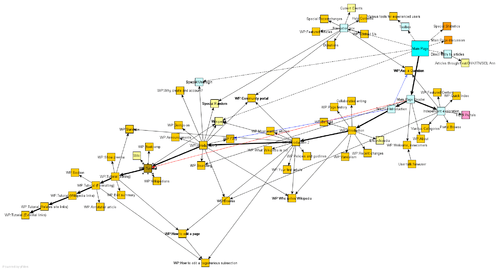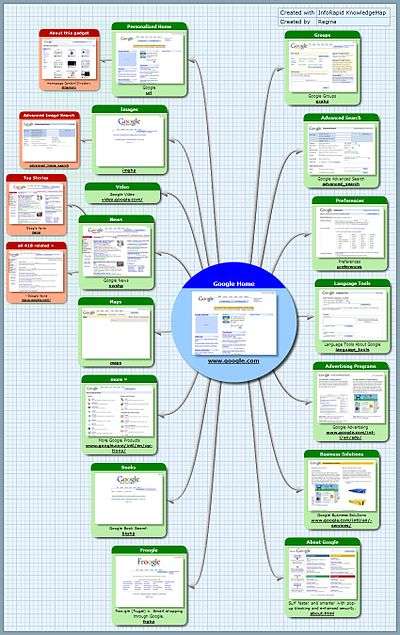Site map
A site map (or sitemap) is a list of pages of a web site.
There are three primary kinds of site map:
- Site maps used during the planning of a Web site by its designers.
- Human-visible listings, typically hierarchical, of the pages on a site.
- Structured listings intended for web crawlers such as search engines.
Types of site maps


Sitemaps may be addressed to users or to software. Many sites have user-visible sitemaps which present a systematic view, typically hierarchical, of the site. These are intended to help visitors find specific pages, and can also be used by crawlers. Alphabetically organized site maps, sometimes called site indexes, are a different approach.
For use by search engines and other crawlers, there is a structured format, the XML Sitemap, which lists the pages in a site, their relative importance, and how often they are updated. This is pointed to from the robots.txt file and is typically called sitemap.xml . The structured format is particularly important for web sites which include pages that are not accessible through links from other pages, but only through the site's search tools or by dynamic construction of URLs in JavaScript or Adobe Flash.
They also act as a navigation aid [1] by providing an overview of a site's content at a single glance.
XML sitemaps
Google introduced the Sitemaps protocol so web developers can publish lists of links from across their sites. The basic premise is that some sites have a large number of dynamic pages that are only available through the use of forms and user entries. The Sitemap files contains URLs to these pages so that web crawlers can find them. Bing, Google, Yahoo and Ask now jointly support the Sitemaps protocol.
Since the major search engines use the same protocol,[2] having a Sitemap lets them have the updated page information. Sitemaps do not guarantee all links will be crawled, and being crawled does not guarantee indexing.[3] Google Webmaster Tools allow a website owner to upload a sitemap that Google will crawl, or they can accomplish the same thing with the robots.txt file.[4]
XML Sitemaps have replaced the older method of "submitting to search engines" by filling out a form on the search engine's submission page. Now web developers submit a Sitemap directly, or wait for search engines to find it. Regularly submitting an updated sitemap when new pages are published may allow search engines to find and index those pages more quickly than it would by finding the pages on its own.[5]
Benefits of XML sitemaps to search-optimize Flash sites
Below is an example of a validated XML sitemap for a simple three page web site. Sitemaps are a useful tool for making sites built in Flash and other non-html languages searchable. If a website's navigation is built with Flash, an automated search program would probably only find the initial homepage; subsequent pages are unlikely to be found without an XML sitemap.
XML sitemap example:
<?xml version="1.0" encoding="UTF-8"?>
<urlset xmlns="http://www.sitemaps.org/schemas/sitemap/0.9">
<url>
<loc>http://www.example.net/?id=who</loc>
<lastmod>2009-09-22</lastmod>
<changefreq>monthly</changefreq>
<priority>0.8</priority>
</url>
<url>
<loc>http://www.example.net/?id=what</loc>
<lastmod>2009-09-22</lastmod>
<changefreq>monthly</changefreq>
<priority>0.5</priority>
</url>
<url>
<loc>http://www.example.net/?id=how</loc>
<lastmod>2009-09-22</lastmod>
<changefreq>monthly</changefreq>
<priority>0.5</priority>
</url>
</urlset>
See also
- Biositemap, a protocol for broadcasting and disseminating information about computational biology resources (data, software tools and web-services)
- Contact page
- Home page
- Index (search engine)
- Link page
- Search engine optimization
- Sitemaps, an XML standard for URL inclusion
- Web indexing
- XML
References
- Site Map Usability Jakob Nielsen's Alertbox, August 12, 2008
- "Google, Yahoo!, Microsoft Standardize Against Google Sitemap Protocol". Oreilly. Retrieved 2012-07-24.
- Joint announcement from Google, Yahoo, Bing supporting Sitemaps
- "Submitting Sitemaps". Google. Retrieved 2012-07-06.
- Foster, Wes (April 5, 2017). "What is a Sitemap?". WESFED.
External links
- Common Official Website - Jointly maintained website by Google, Yahoo, MSN for an XML sitemap format.
- Sitemap generators at Curlie